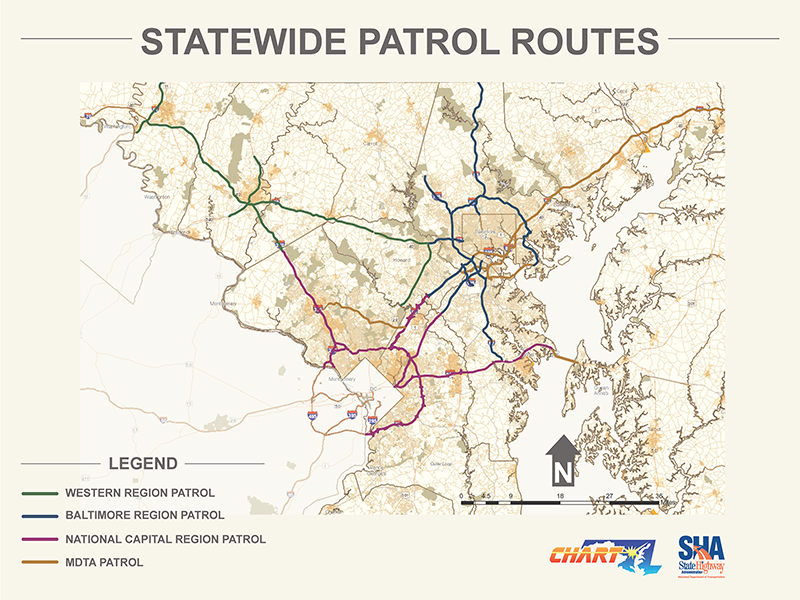(July 15, 2014) – To keep travelers safe and traffic moving, Maryland’s CHART (Coordinated Highways Action Response Team) program deploys emergency traffic patrols on major highways across the region. The teams, sponsored by State Farm®, assisted more than 26,500 stranded motorists last year and supported police with traffic control at nearly 17,500 incidents. The State Highway Administration (SHA) today announced the patrols now operate 24-hours-a-day, seven days a week in the Baltimore and Washington metropolitan areas.

“One of the most dangerous speeds along a highway is zero – a collision between a stopped vehicle and another traveling 55 mph or more is catastrophic. Our emergency patrols assist stranded motorists and get them out of harm’s way,” said SHA Administrator Melinda B. Peters. “The 24-7 expansion allows us to quickly respond to after-hours and weekend incidents as well as change flat tires and jump-start vehicles. The patrols are a wonderful customer service and more importantly, a critical safety program.”
Additionally, SHA announced plans to install
74 new traffic cameras across the state over the next two years. The cameras bring the program’s total to nearly 300, although CHART operators have access to nearly 700 through partnership agreements with other agencies. Between the new cameras and the additional patrols, SHA will invest nearly $15 million in the CHART program expansion.
With a combination of on-the-road response along with the latest technologies (CCTV, dynamic message signs, weather pavement sensors, speed sensors) in 2012 CHART saved drivers approximately $1 billion in fuel and delay costs, prevented nearly 225 secondary crashes and reduced motorists delay by 28.4 million vehicle hours.
“Motorists in Maryland are safer because of emergency traffic patrols and our 30 plus year relationship with the CHART program is stronger than ever,” said MSP Northern Command, Field Operation Bureau Major Clifford Hughes. “The Maryland State Police reminds motorists to Move Over to allow our troopers and the SHA ETP’s a safe environment to clear crashes from Maryland’s roads.”
The public can view cameras and much of the information available to CHART operators through 511, a free traveler information phone service and
www.md511.org . With 511 travelers can “Know Before You Go!,” by calling, accessing the web site and registering for automatic email or text traffic alerts on frequently traveled state routes through “My 511.”
Sponsored by State Farm®, CHART emergency traffic patrols now include 48 drivers and vehicles with 24-7 coverage in the metro regions and weekday coverage from 5 a.m. to 9 p.m. in Frederick, as well as weekends in the Annapolis/Eastern Shore area.
Last year, Katherine Wirth was traveling on I-95 when her brakes locked up, causing her vehicle to become disabled. “No one ever expects their vehicle to suddenly break down and be in such a vulnerable position on the road,” said Ms. Wirth. “But within minutes, the ERT pulled up, protected the scene and safely guided me to the shoulder. You don’t realize how important these patrols are until you need one.”
SHA receives hundreds of letters, emails and social media posts, thanking the patrols for assistance. A few of the comments received in the past two months include, “I am more than grateful for their quick response and professionalism;” “I was ecstatic that my tax dollars go to such great use;” “The ETP was cheerful and efficient in changing my tire;” and “Your driver saved my life when I broke down in the center lane. He took control and stayed with me until I was safe.”
The CHART program headquarters is located near Baltimore Washington Thurgood Marshall International Airport. CHART is a joint effort of the Maryland Department of Transportation (MDOT)/SHA, Maryland Transportation Authority (MDTA) and the Maryland State Police (MSP), in cooperation with other federal, state and local agencies. The incident management initiative grew from the Reach the Beach Program in the 1980’s, which focused on reducing traffic and delays from Annapolis to Ocean City. CHART now has a statewide operations center and several regional operations centers across the State.
Motorists can report disabled vehicles to #77, so that CHART or Maryland State Police assistance can be deployed. If you become disabled or if you become involved in a collision, move your vehicle safely from the travel lanes onto the nearest shoulder when possible. Never try to cross interstate lanes for assistance; call #77 or 911 or wait for assistance.
# # #